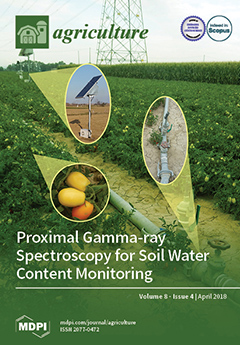This study was conducted to examine the translocation of highly residual agrochemical in soil, the endosulfan (total), to ginseng (
Panax ginseng C. A. Meyer). The soil with the level of the amount of 5.0 mg kg
−1 of endosulfan (total) was prepared
[...] Read more.
This study was conducted to examine the translocation of highly residual agrochemical in soil, the endosulfan (total), to ginseng (
Panax ginseng C. A. Meyer). The soil with the level of the amount of 5.0 mg kg
−1 of endosulfan (total) was prepared in a Wagner pot into which the seedling of ginseng was transplanted and then the specimens of ginseng (root, leaf, and stem) were collected quarterly and analyzed through GC-MS. The level of residual of endosulfan (total) in the soil has decreased from 4.28 mg kg
−1 (April 2013) to 1.94 mg kg
−1 (December 2014) while the level in the specimens of leaf and stem of ginseng respectively sampled according to its growth phase in June and September from 2013 and 2014 showed an increase from 0.56 mg kg
−1 (June 2013) to 2.46 mg kg
−1 (September 2013) and decrease from 0.29 mg kg
−1 (June 2014) to 0.18 mg kg
−1 (September 2014). For the case of the root of ginseng, the level of the amount of 10.77 mg kg
−1 of endosulfan (total) was detected in June 2013 and then, the level has decreased to the level of 4.88 mg kg
−1 in December 2014. The translocation of residual endosulfan (total) in soil to ginseng with time was identified. The amount of residuals of α-endosulfan and β-endosulfan was also decreased with time however, the ratio of endosulfan-sulfate, the main metabolite, was gradually increasing. The retention of metabolite (endosulfan-sulfate) in soil identified thereby thus suggests the potential of its translocation to plants in the case of the soils containing the residual of endosulfan (total).
Full article





